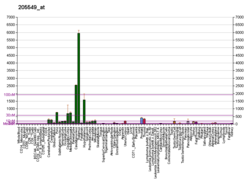| PCP4 | |||||||||||||||||||||||||||||||||||||||||||||||||||
|---|---|---|---|---|---|---|---|---|---|---|---|---|---|---|---|---|---|---|---|---|---|---|---|---|---|---|---|---|---|---|---|---|---|---|---|---|---|---|---|---|---|---|---|---|---|---|---|---|---|---|---|
| Identifiers | |||||||||||||||||||||||||||||||||||||||||||||||||||
| Aliases | PCP4 , PEP-19, Purkinje cell protein 4 | ||||||||||||||||||||||||||||||||||||||||||||||||||
| External IDs | OMIM: 601629; MGI: 97509; HomoloGene: 4519; GeneCards: PCP4; OMA:PCP4 - orthologs | ||||||||||||||||||||||||||||||||||||||||||||||||||
| |||||||||||||||||||||||||||||||||||||||||||||||||||
| |||||||||||||||||||||||||||||||||||||||||||||||||||
| |||||||||||||||||||||||||||||||||||||||||||||||||||
| |||||||||||||||||||||||||||||||||||||||||||||||||||
| |||||||||||||||||||||||||||||||||||||||||||||||||||
| Wikidata | |||||||||||||||||||||||||||||||||||||||||||||||||||
| |||||||||||||||||||||||||||||||||||||||||||||||||||
Purkinje cell protein 4 is a protein that in humans is encoded by the PCP4 gene. [5] [6] [7] Also known as PEP-19, PCP4 is a 7.6 kDa protein with an IQ-motif that binds to calmodulin (CaM). [8] PCP4 is abundant in Purkinje cells of the cerebellum, and plays an important role in synaptic plasticity. [8] [9]




